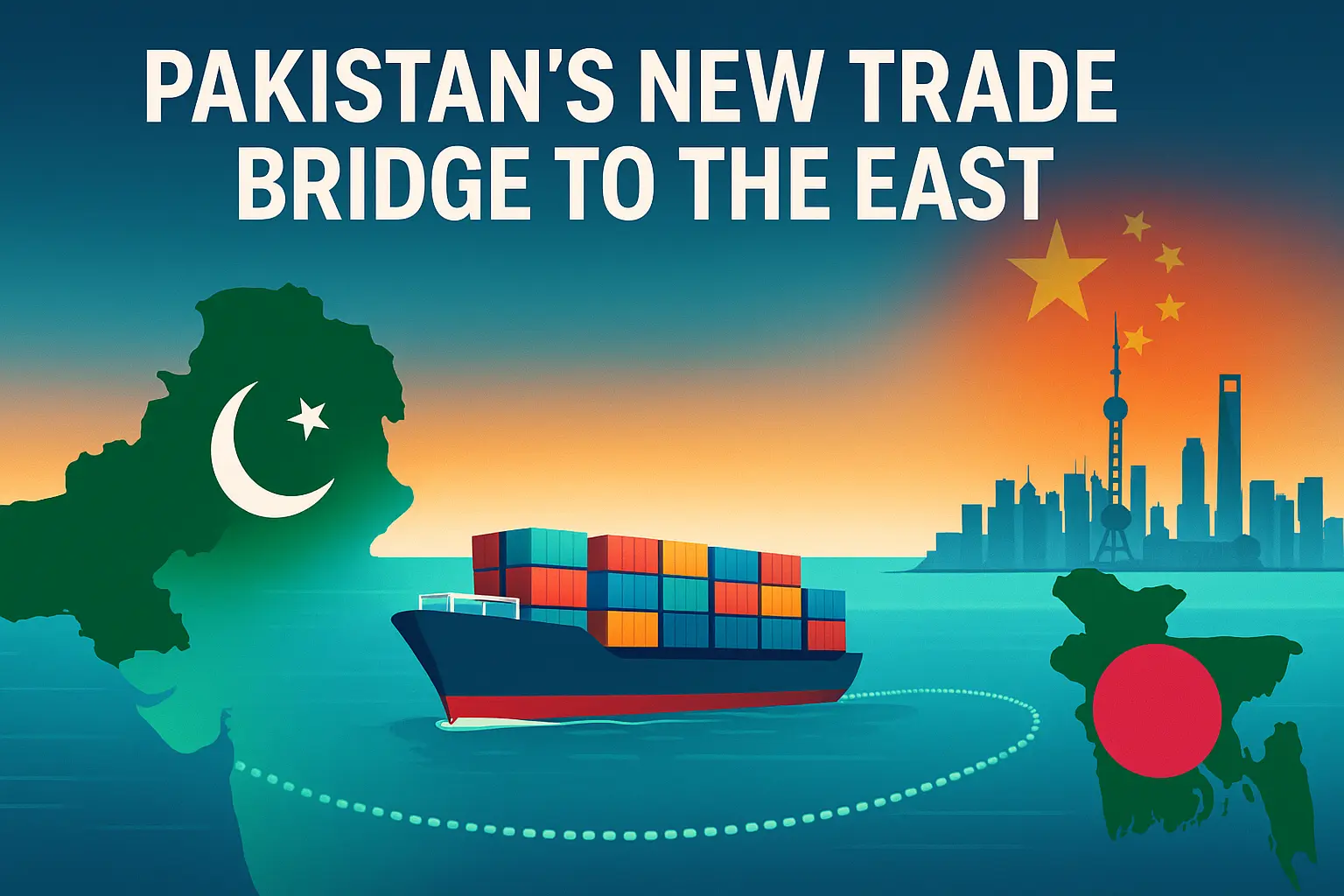In a significant diplomatic overture, Pakistan has proposed that Bangladesh use Karachi Port as a transit hub for trade with China. The idea—simple in form but complex in implication—aims to reshape the South Asian maritime landscape by adding a new trade artery linking the Arabian Sea, Bay of Bengal, and South China Sea.
This proposal, to be discussed during the Bangladesh–Pakistan Joint Economic Commission (JEC) meeting in Dhaka, could mark the most consequential shift in Pakistan–Bangladesh relations in decades. Yet, beneath the optimism lie numerous “ifs” and “buts” that will decide whether this becomes a genuine trade corridor or a symbolic diplomatic gesture.
The Proposed Route: Karachi–Chattogram–Shanghai Corridor
Textual Diagram (Simplified Overview):
KARACHI PORT (Pakistan)
↓
Arabian Sea Route (~2,900 km)
↓
CHATTOGRAM PORT (Bangladesh)
↓
Bay of Bengal + South China Sea (~3,600 km)
↓
SHANGHAI PORT (China)
This conceptual route emphasizes Pakistan’s geographic advantage on the Arabian Sea and its potential to act as a maritime bridge connecting South and East Asia through Bangladesh.
Diplomatic and Strategic Dimensions
1. Rebuilding Trust with Bangladesh
For over five decades, Islamabad and Dhaka maintained a frosty relationship rooted in the 1971 war legacy. This port proposal reflects Pakistan’s attempt to reset ties through economic diplomacy, replacing political estrangement with pragmatic cooperation.
The first direct Karachi–Chattogram cargo link in November 2024 was a quiet but historic step. Now, a formal shipping and trade agreement could institutionalize this link—if both sides overcome lingering mistrust.
2. China’s Expanding Connectivity Web
For China, the corridor offers another maritime spoke in its Belt and Road Initiative (BRI). It complements China’s land-based corridors (CPEC via Gwadar) and strengthens Beijing’s strategic redundancy—multiple trade paths ensure resilience against regional disruptions.
By engaging both Pakistan and Bangladesh, China also signals its intent to broaden cooperation beyond traditional partners, weaving a trilateral fabric of connectivity.
3. Shifting Regional Geometry
India’s geographic dominance in South Asian transit has long been a structural reality. A Karachi–Bangladesh route would give Dhaka a non-Indian option for trade with China—altering the subcontinental logistics balance.
For Pakistan, it opens a new diplomatic avenue to counter isolation and portray itself as a bridge, not a buffer, between South and East Asia.
Economic Prospects
Short-Term Benefits (1–3 Years)
•Direct Maritime Link: The planned BSC–PNSC MoU could establish regular Karachi–Chattogram cargo operations.
•Reduced Costs: A Karachi-based trans-shipment may lower freight and insurance costs versus third-country ports.
•Trade Expansion: Bangladesh’s exports to Pakistan ($57 million FY 2023–24) could expand significantly if logistic friction drops.
•Symbolic Trust-Building: Early success would enhance political goodwill and investor confidence.
Long-Term Potential (5–15 Years)
•Logistics Hub Transformation: Karachi could evolve into a South Asia maritime logistics hub, with industrial zones, bonded warehouses, and re-export facilities.
•Supply-Chain Integration: A unified Pakistan–Bangladesh–China corridor could enable regional value-chain manufacturing, complementing each country’s strengths—Bangladesh in garments, China in technology, Pakistan in logistics.
•Revenue Diversification: Pakistan could generate steady port fees and service income, easing its balance-of-payments strain.
•Regional Resilience: The corridor would diversify trade flows, reduce over-reliance on Indian or Singaporean routes, and strengthen South–South connectivity.
The “Ifs” and “Buts”
Ifs (Opportunities)
Buts (Challenges)
If Karachi upgrades its port capacity, expands berths, and improves customs efficiency, the corridor can scale quickly.
But infrastructure bottlenecks—delays, congestion, or outdated equipment—could erase cost advantages.
If regular, affordable shipping lines operate between Karachi and Chattogram, private traders will adopt the route.
But unreliable schedules or small cargo volumes would deter shippers from switching.
If the three nations align customs and transit regulations, clearance could become seamless.
But bureaucratic red tape in either Pakistan or Bangladesh could make the route slower than current options.
If maritime security remains stable, insurers and investors will trust the route.
But security threats or regional tensions could quickly raise costs or halt movement.
If Bangladesh balances its trade portfolio, the corridor will benefit all.
But a growing trade imbalance (Pakistan exporting more than importing) could politically sour the partnership.
Strategic Scenarios
Scenario A – The Success Story
Karachi becomes a major trans-shipment hub; China and Bangladesh integrate the route into regular trade cycles. Pakistan earns billions in logistics revenues, and South Asia’s maritime map diversifies beyond India.
Scenario B – The Middle Path
Limited success: some cargo uses Karachi, but infrastructural and bureaucratic hurdles persist. The route functions as a secondary corridor, politically symbolic yet economically modest.
Scenario C – The Lost Opportunity
Agreements are signed but not operationalized. Lack of investment, slow reforms, or geopolitical pushback render the initiative stagnant—a missed chance for regional integration.
Policy Recommendations
For Pakistan
•Prioritize Karachi Port modernization (automation, rail linkage, customs reform).
•Launch a logistics branding campaign positioning Karachi as “South Asia’s Western Gateway.”
•Ensure maritime security and investor confidence through visible protection measures.
For Bangladesh
•Conduct a comprehensive cost–benefit study comparing Karachi vs. existing trade routes.
•Diversify exports toward sectors benefiting from shorter sea legs.
•Secure balanced trade terms to avoid dependency or asymmetry.
For China
•Integrate the corridor under the Maritime Silk Road framework.
•Offer technical and financing support for port and shipping infrastructure.
•Use this corridor as a pilot for regional trilateral trade cooperation in South Asia.
Conclusion
Pakistan’s proposal to open Karachi Port for China–Bangladesh trade is a strategic gamble with high potential and equally high uncertainty.
It could either become a defining success story of South–South connectivity or fade into another unrealized diplomatic initiative.
Its fate rests on four determinants:
1.Infrastructure readiness at Karachi,
2.Regulatory coordination among the three partners,
3.Security and stability, and
4.Sustained political will beyond symbolic gestures.
If these align, this corridor could truly redefine regional economics and geopolitics—transforming Pakistan from a passive actor into an active hub linking South Asia’s manufacturing heartland with East Asia’s industrial core.
If not, it risks remaining just another “what-could-have-been” in the long list of regional connectivity dreams.










